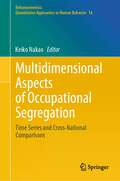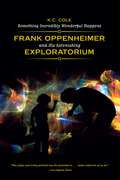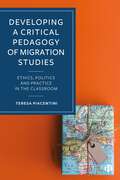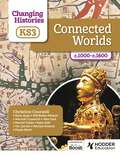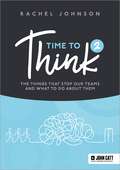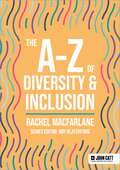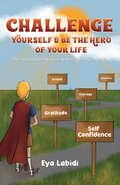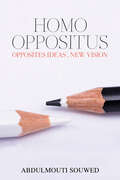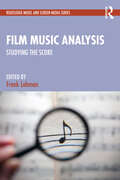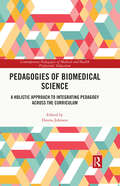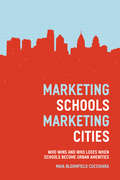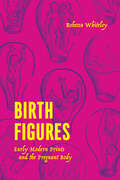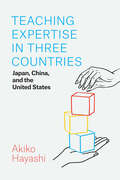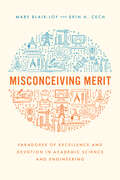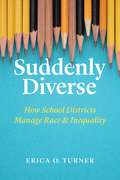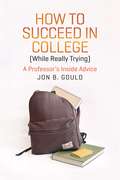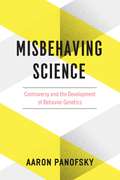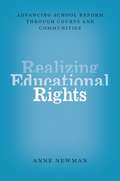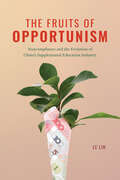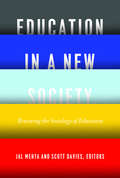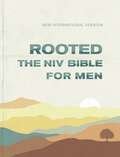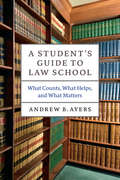- Table View
- List View
Multidimensional Aspects of Occupational Segregation: Time Series and Cross-National Comparisons (Behaviormetrics: Quantitative Approaches to Human Behavior #18)
by Keiko NakaoOne of the strengths of this book is that it expresses occupational segregation from multidimensional viewpoints using correspondence analysis. Through a quantitative approach, the book examines occupational segregation by education and gender in response to industrial transformation in Japan and other countries. The transformation of industrial structure, such as post-industrialization, demands a reconsideration of traditional perspectives in sociology, especially in social stratification. In other words, it is a shift from the attribute to the achievement principle. Higher technological innovations will create higher levels of industries, and those industries will require jobs that need greater human capital. In short, the meritocracy will be promoted. Meritocracy is certainly considered persuasive. In fact, previous researchers have looked primarily at a person’s occupation as a measure of social status. In Japan, jobs are normally acquired after completing education; thus, one’s educational achievement plays an important role. Especially in recent years, however, education alone has not been enough to explain social status. This book, therefore, focuses on occupational segregation by gender in addition to education in post-industrial society. Can occupational segregation by gender be weakened in the highly educated group? Is this a universal story in modern society? Because post-industrialization is part of the larger story of modernization, international perspectives are needed to examine the linkage between education and gender occupational segregation. This book explores occupational segregation by gender in response to industrial transformation in Japan and other countries.
Something Incredibly Wonderful Happens: Frank Oppenheimer and His Astonishing Exploratorium
by K.C. ColeHow do we reclaim our innate enchantment with the world? And how can we turn our natural curiosity into a deep, abiding love for knowledge? Frank Oppenheimer, the younger brother of the physicist J. Robert Oppenheimer, was captivated by these questions, and used his own intellectual inquisitiveness to found the Exploratorium, a powerfully influential museum of human awareness in San Francisco, that encourages play, creativity, and discovery—all in the name of understanding. In this elegant biography, K. C. Cole investigates the man behind the museum with sharp insight and deep sympathy. The Oppenheimers were a family with great wealth and education, and Frank, like his older brother, pursued a career in physics. But while Robert was unceasingly ambitious, and eventually came to be known for his work on the atomic bomb, Frank’s path as a scientist was much less conventional. His brief fling with the Communist Party cost him his position at the University of Minnesota, and he subsequently spent a decade ranching in Colorado before returning to teaching. Once back in the lab, however, Frank found himself moved to create something to make the world meaningful after the bombing of Hiroshima and Nagasaki. He was inspired by European science museums, and he developed a dream of teaching Americans about science through participatory museums. Thus was born the magical world of the Exploratorium, forever revolutionizing not only the way we experience museums, but also science education for years to come. Cole has brought this charismatic and dynamic figure to life with vibrant prose and rich insight into Oppenheimer as both a scientist and an individual.
Developing a Critical Pedagogy of Migration Studies: Ethics, Politics and Practice in the Classroom
by Teresa PiacentiniMigration as a taught subject is entrenched in social and political debates, with the classroom firmly framed as a site of committed social and political encounter. That means teaching migration through the prism of critical pedagogy is a political and ethical necessity. This book invites readers to examine their own relationships with migration, ethics, politics and power. It encourages teachers, students and practitioners to think critically about their position in relation to the knowledge they both bring and gain. With pedagogical features that provide space for reflection and discussion, this is a transformative resource in reshaping how we teach and learn about migration.
Changing Histories for KS3: C.1000c.1600
by Christine Counsell Katie Hall Alex Ford Rachel Foster Tim Jenner Kerry Apps Will Bailey-Watson Hannah Cusworth Nicolas Kinloch Paula WorthChange the history that pupils learn at Key Stage 3. Reframe familiar topics, discover forgotten stories and amplify unheard voices.Through an evocative, story-based approach, this ground-breaking course brings together historical scholarship and enquiry, presenting a truly diverse, inclusive and ambitious history curriculum.This is the history we owe to our pupils. This is the past for today and tomorrow.> Establish a strong foundation of British history. A clear, chronological spine underpins each book, empowering pupils with the knowledge they need to understand, question or disrupt national narratives.> Journey far beyond Britain. Move between local and global, between small details and wider developments, as the books blend depth and overview, expanding pupils' knowledge of people, places and events around the world and the links between them.> Use the power of story to transform your teaching. Captivated by vivid, intriguing narratives, pupils will remember more than they ever have before. See their literacy improve as they encounter a wide vocabulary in context, become immersed in rich, quality texts, and enjoy hearing the book read aloud or reading it themselves.> Teach a diverse curriculum with confidence. Gender, class, race and religion are treated with sensitivity and sophistication, intrinsically woven into the content to create perspective on social, economic, religious and political history.> Stay up to date with historical scholarship. The authors have undertaken extensive reading, so every chapter is informed by current research from historians such as Helen Castor, Ruby Lal and Toby Green.> Deliver the aspirational curriculum that Ofsted expects. The course embodies the requirements for scope, coherence, rigour and sequencing. The Changing Histories curriculum is a progression model. Skills and knowledge are built systematically across each lesson sequence and new material makes sense to pupils because of the content covered earlier.> Trust a meticulously planned approach. Each 'enquiry' chapter helps pupils to shape an extended answer to the overarching question, with carefully paced 'steps' that support pupils in processing substantive knowledge. Shorter 'story summary' chapters keep narratives moving in between the enquiries.> Benefit from some of the best minds in history education. Leaders in history curriculum, practice, research and debate, the authors have poured their expertise into every page, making quality history accessible to all.
Time to Think 2: The things that stop our teams and what to do about them
by Rachel JohnsonBeing a leader involves having followers and working as a team. Sometimes our teams get stuck and issues emerge that we don't always feel equipped to deal with. How do we get buy in, keep momentum, recognise and overcome dysfunction, and get the best out of introverts and extroverts so that everyone feels safe and brave? This book is for people who want to be daring and responsible in their leadership, who want to embrace paradoxes, and understand how to create and maintain thriving teams. Use this book to help you work through the issues that are most relevant to you and your teams so that you, and they, can thrive.
The A-Z of Diversity & Inclusion (John Catt A-Z series)
by Rachel MacfarlaneThe A-Z of Diversity and Inclusion is a powerful blend of advice, reflection and provocation on these vital topics, organised around the 26 letters of the English alphabet.Great educators recognise how diversity enriches their organisation. They have an ambition for every learner (adult and child) to be seen, represented and included, for their needs to be met and any barriers they are experiencing to be understood, tackled and overcome. To achieve this requires dogged determination, relentless and forensic focus and unwavering optimism and energy.Inclusive educators quite literally change lives.
Changing Histories for KS3: C.1000c.1600
by Christine Counsell Katie Hall Alex Ford Rachel Foster Tim Jenner Kerry Apps Will Bailey-Watson Hannah Cusworth Nicolas Kinloch Paula WorthChange the history that pupils learn at Key Stage 3. Reframe familiar topics, discover forgotten stories and amplify unheard voices.Through an evocative, story-based approach, this ground-breaking course brings together historical scholarship and enquiry, presenting a truly diverse, inclusive and ambitious history curriculum.This is the history we owe to our pupils. This is the past for today and tomorrow.> Establish a strong foundation of British history. A clear, chronological spine underpins each book, empowering pupils with the knowledge they need to understand, question or disrupt national narratives.> Journey far beyond Britain. Move between local and global, between small details and wider developments, as the books blend depth and overview, expanding pupils' knowledge of people, places and events around the world and the links between them.> Use the power of story to transform your teaching. Captivated by vivid, intriguing narratives, pupils will remember more than they ever have before. See their literacy improve as they encounter a wide vocabulary in context, become immersed in rich, quality texts, and enjoy hearing the book read aloud or reading it themselves.> Teach a diverse curriculum with confidence. Gender, class, race and religion are treated with sensitivity and sophistication, intrinsically woven into the content to create perspective on social, economic, religious and political history.> Stay up to date with historical scholarship. The authors have undertaken extensive reading, so every chapter is informed by current research from historians such as Helen Castor, Ruby Lal and Toby Green.> Deliver the aspirational curriculum that Ofsted expects. The course embodies the requirements for scope, coherence, rigour and sequencing. The Changing Histories curriculum is a progression model. Skills and knowledge are built systematically across each lesson sequence and new material makes sense to pupils because of the content covered earlier.> Trust a meticulously planned approach. Each 'enquiry' chapter helps pupils to shape an extended answer to the overarching question, with carefully paced 'steps' that support pupils in processing substantive knowledge. Shorter 'story summary' chapters keep narratives moving in between the enquiries.> Benefit from some of the best minds in history education. Leaders in history curriculum, practice, research and debate, the authors have poured their expertise into every page, making quality history accessible to all.
Time to Think 2: The things that stop our teams and what to do about them
by Rachel JohnsonBeing a leader involves having followers and working as a team. Sometimes our teams get stuck and issues emerge that we don't always feel equipped to deal with. How do we get buy in, keep momentum, recognise and overcome dysfunction, and get the best out of introverts and extroverts so that everyone feels safe and brave? This book is for people who want to be daring and responsible in their leadership, who want to embrace paradoxes, and understand how to create and maintain thriving teams. Use this book to help you work through the issues that are most relevant to you and your teams so that you, and they, can thrive.
The A-Z of Diversity & Inclusion (John Catt A-Z series)
by Rachel MacfarlaneThe A-Z of Diversity and Inclusion is a powerful blend of advice, reflection and provocation on these vital topics, organised around the 26 letters of the English alphabet.Great educators recognise how diversity enriches their organisation. They have an ambition for every learner (adult and child) to be seen, represented and included, for their needs to be met and any barriers they are experiencing to be understood, tackled and overcome. To achieve this requires dogged determination, relentless and forensic focus and unwavering optimism and energy.Inclusive educators quite literally change lives.
Challenge Yourself & Be the Hero of your Life: Personal Development & Positive Psychology
by Eya LabidiThis book is designed to lay the foundation for a solid and positive upbringing, starting from a child’s first readings and continuing through their teenage years and into adulthood. Written in accessible language, this book engages young readers and captures their attention through independent chapters, each focusing on a specific and fundamental concept. Every section concludes with dynamic, practical exercises related to the notion studied, providing children with valuable advice that is both motivating and challenging enough to help them develop new skills. Among the many treasures within these pages, children will find tools to promote self-expression, personal development, and self-confidence. They will learn how to overcome fears, believe in themselves, unravel emotional blockages, and nurture their natural curiosity. In essence, this book is an exciting adventure where the beloved reader is both the superhero and the heart of its content. By embarking on this journey, children will be well-prepared to face the challenges of growing up, armed with the knowledge and skills necessary to lead fulfilling and successful lives. This book is an invaluable resource for parents and educators who wish to support the positive development of the children in their care.
Homo Oppositus: Opposites Ideas , New Vision
by Abdulmouti SouwedThe core concept of this book is one that resonates with everyone, yet it is explored and presented in a fresh and unique perspective as envisioned by the author. After delving into and discussing this familiar idea, the author arrives at a profound conclusion: that humans embody contradictions within themselves. This introspection leads back to the timeless question: what truly defines a human? In this insightful exploration, the author proposes that humanity is inherently chaotic and self-contradictory. This raises a compelling question in our current era of digital advancement and artificial intelligence: Are we, as a species, still influenced by an ‘archaic mindset’ in this modern age? This book challenges readers to reconsider their understanding of human nature in the context of rapidly evolving technology.
Film Music Analysis: Studying the Score (Routledge Music and Screen Media Series)
by Frank LehmanSince the establishment of film music studies, there has been a steady growth of serious analytical work on the film music repertoire. Film Music Analysis: Studying the Score offers the first collection of essays dedicated to the close investigation of musical structure and meaning in film music. Showcasing scholarship from a diverse and distinguished group of music theorists and musicologists, this book presents the many ways to inspect the inner workings of film music in a manner that is exciting and accessible to anyone curious about this music, regardless of their background in film or music theory.Each chapter takes as its focus one music-theoretical parameter and explores how that concept can be used to analyze and interpret film music. Covering theoretical concepts that range from familiar categories such as leitmotif and pitch structure to more cutting-edge ideas such as timbral associativity, topic theory, and metrical states, the book provides a toolkit with which to explore this captivatingly varied repertoire. With example analyses drawn from classic and contemporary films, Film Music Analysis: Studying the Score is a valuable teaching tool and an indispensable addition to the library of any lover of film and music.
Pedagogies of Biomedical Science: A Holistic Approach to Integrating Pedagogy Across the Curriculum (Contemporary Pedagogies of Medical and Health Professions’ Education)
by Donna JohnsonThis book confronts the continually evolving nature of biomedical science education by providing a robust account of learning pedagogies and best practice for scholars and researchers in the field.Rather than considering subdisciplines of biomedical science education separately, the volume takes a holistic approach and considers the complexities of teaching biomedical science as a whole, providing a nuanced overview of how a particular practice fits in such a course overall, as well as providing support for development within the reader’s own subdiscipline. Ultimately, this holistic approach allows for expansive discussion of relevant pedagogical approaches that will directly inform innovations in the contemporary teaching of biomedical science education.Novel in approach and underpinned by the latest in research innovations, this book will appeal to scholars, researchers and postgraduate students in the fields of medical education, higher education, and curriculum studies. Policy makers involved with health education and promotion as well as educational research will also benefit from the volume.
Marketing Schools, Marketing Cities: Who Wins and Who Loses When Schools Become Urban Amenities
by Maia Bloomfield CucchiaraDiscuss real estate with any young family and the subject of schools is certain to come up—in fact, it will likely be a crucial factor in determining where that family lives. Not merely institutions of learning, schools have increasingly become a sign of a neighborhood’s vitality, and city planners have ever more explicitly promoted “good schools” as a means of attracting more affluent families to urban areas, a dynamic process that Maia Bloomfield Cucchiara critically examines in Marketing Schools, Marketing Cities. Focusing on Philadelphia’s Center City Schools Initiative, she shows how education policy makes overt attempts to prevent, or at least slow, middle-class flight to the suburbs. Navigating complex ethical terrain, she balances the successes of such policies in strengthening urban schools and communities against the inherent social injustices they propagate—the further marginalization and disempowerment of lowerclass families. By asking what happens when affluent parents become “valued customers,” Marketing Schools, Marketing Cities uncovers a problematic relationship between public institutions and private markets, where the former are used to leverage the latter to effect urban transformations.
Birth Figures: Early Modern Prints and the Pregnant Body
by Rebecca WhiteleyThe first full study of “birth figures” and their place in early modern knowledge-making. Birth figures are printed images of the pregnant womb, always shown in series, that depict the variety of ways in which a fetus can present for birth. Historian Rebecca Whiteley coined the term and here offers the first systematic analysis of the images’ creation, use, and impact. Whiteley reveals their origins in ancient medicine and explores their inclusion in many medieval gynecological manuscripts, focusing on their explosion in printed midwifery and surgical books in Western Europe from the mid-sixteenth to the mid-eighteenth century. During this period, birth figures formed a key part of the visual culture of medicine and midwifery and were widely produced. They reflected and shaped how the pregnant body was known and treated. And by providing crucial bodily knowledge to midwives and surgeons, birth figures were also deeply entangled with wider cultural preoccupations with generation and creativity, female power and agency, knowledge and its dissemination, and even the condition of the human in the universe. Birth Figures studies how different kinds of people understood childbirth and engaged with midwifery manuals, from learned physicians to midwives to illiterate listeners. Rich and detailed, this vital history reveals the importance of birth figures in how midwifery was practiced and in how people, both medical professionals and lay readers, envisioned and understood the mysterious state of pregnancy.
Teaching Expertise in Three Countries: Japan, China, and the United States
by Akiko HayashiA comparison of the development of expertise in preschool teaching in China, Japan, and the United States. In Teaching Expertise in Three Countries, Akiko Hayashi shows how teachers from Japan, China, and the United States think about what it means to be an expert teacher. Based on interviews with teachers conducted over the span of fifteen years and videos taken in their classrooms, Hayashi gives us a valuable portrait of expert teachers in the making. While Hayashi’s research uncovered cultural variations in the different national contexts, her analysis of how teachers adapted their pedagogy throughout their careers also revealed many cross-national similarities. Younger teachers often describe themselves as being in a rush, following scripts, and “talking too much,” while experienced teachers describe themselves as being quieter, knowing children better, and being more present. Including a foreword by scholar of early childhood education Joseph Tobin, Teaching Expertise in Three Countries provides a foundation for understanding the sequence and pathways of development over the first decade of teaching in three national contexts, demonstrating the value of the field of comparative education in the process.
Misconceiving Merit: Paradoxes of Excellence and Devotion in Academic Science and Engineering
by Mary Blair-Loy Erin A. CechAn incisive study showing how cultural ideas of merit in academic science produce unfair and unequal outcomes. In Misconceiving Merit, sociologists Mary Blair-Loy and Erin A. Cech uncover the cultural foundations of a paradox. On one hand, academic science, engineering, and math revere meritocracy, a system that recognizes and rewards those with the greatest talent and dedication. At the same time, women and some racial and sexual minorities remain underrepresented and often feel unwelcome and devalued in STEM. How can academic science, which so highly values meritocracy and objectivity, produce these unequal outcomes? Blair-Loy and Cech studied more than five hundred STEM professors at a top research university to reveal how unequal and unfair outcomes can emerge alongside commitments to objectivity and excellence. The authors find that academic STEM harbors dominant cultural beliefs that not only perpetuate the mistreatment of scientists from underrepresented groups but hinder innovation. Underrepresented groups are often seen as less fully embodying merit compared to equally productive white and Asian heterosexual men, and the negative consequences of this misjudgment persist regardless of professors’ actual academic productivity. Misconceiving Merit is filled with insights for higher education administrators working toward greater equity as well as for scientists and engineers striving to change entrenched patterns of inequality in STEM.
Suddenly Diverse: How School Districts Manage Race and Inequality
by Erica O. TurnerFor the past five years, American public schools have enrolled more students identified as Black, Latinx, American Indian, and Asian than white. At the same time, more than half of US school children now qualify for federally subsidized meals, a marker of poverty. The makeup of schools is rapidly changing, and many districts and school boards are at a loss as to how they can effectively and equitably handle these shifts.Suddenly Diverse is an ethnographic account of two school districts in the Midwest responding to rapidly changing demographics at their schools. It is based on observations and in-depth interviews with school board members and superintendents, as well as staff, community members, and other stakeholders in each district: one serving “Lakeside,” a predominately working class, conservative community and the other serving “Fairview,” a more affluent, liberal community. Erica O. Turner looks at district leaders’ adoption of business-inspired policy tools and the ultimate successes and failures of such responses. Turner’s findings demonstrate that, despite their intentions to promote “diversity” or eliminate “achievement gaps,” district leaders adopted policies and practices that ultimately perpetuated existing inequalities and advanced new forms of racism. While suggesting some ways forward, Suddenly Diverse shows that, without changes to these managerial policies and practices and larger transformations to the whole system, even district leaders’ best efforts will continue to undermine the promise of educational equity and the realization of more robust public schools.
How to Succeed in College: A Professor's Inside Advice (Chicago Guides To Academic Life Ser.)
by Jon B. GouldAfter years of preparation and anticipation, many students arrive at college without any real knowledge of the ins and outs of college life. They’ve been focused on finding the right school and have been carefully guided through the nuances of the admissions process, but too often they have little knowledge about how college will be different from high school or what will be expected of them during that crucial first year and beyond. Written by an award-winning teacher, How to Succeed in College (While Really Trying) provides much-needed help to students, offering practical tips and specific study strategies that will equip them to excel in their new environment. Drawing on years of experience teaching at a variety of campuses, from large research universities to small liberal arts colleges, Jon B. Gould gives readers the lay of the land and demystifies the college experience. In the course of the book, students will learn how to identify the best instructors, how to choose classes and settle on a major, how to develop effective strategies for reading and note taking, and how to write good papers and successfully complete exams. Because much of the college experience takes place outside of the classroom, Gould also advises students on how to effectively manage their cocurricular activities, work obligations, and free time, as well as how to take advantage of the typically untapped resources on every campus. With candid advice and insights from a seasoned insider, this guide will leave students better prepared not only to succeed in college but to enjoy it as well.
Misbehaving Science: Controversy and the Development of Behavior Genetics
by Aaron PanofskyBehavior genetics has always been a breeding ground for controversies. From the “criminal chromosome” to the “gay gene,” claims about the influence of genes like these have led to often vitriolic national debates about race, class, and inequality. Many behavior geneticists have encountered accusations of racism and have had their scientific authority and credibility questioned, ruining reputations, and threatening their access to coveted resources. In Misbehaving Science, Aaron Panofsky traces the field of behavior genetics back to its origins in the 1950s, telling the story through close looks at five major controversies. In the process, Panofsky argues that persistent, ungovernable controversy in behavior genetics is due to the broken hierarchies within the field. All authority and scientific norms are questioned, while the absence of unanimously accepted methods and theories leaves a foundationless field, where disorder is ongoing. Critics charge behavior geneticists with political motivations; champions say they merely follow the data where they lead. But Panofsky shows how pragmatic coping with repeated controversies drives their scientific actions. Ironically, behavior geneticists’ struggles for scientific authority and efforts to deal with the threats to their legitimacy and autonomy have made controversy inevitable—and in some ways essential—to the study of behavior genetics.
Realizing Educational Rights: Advancing School Reform through Courts and Communities
by Anne NewmanIn Realizing Educational Rights, Anne Newman examines two educational rights questions that arise at the intersection of political theory, educational policy, and law: What is the place of a right to education in a participatory democracy, and how can we realize this right in the United States? Tracking these questions across both philosophical and pragmatic terrain, she addresses urgent moral and political questions, offering a rare, double-pronged look at educational justice in a democratic society. Newman argues that an adequate K–12 education is the right of all citizens, as a matter of equality, and emphasizes that this right must be shielded from the sway of partisan and majoritarian policy making far more than it currently is. She then examines how educational rights are realized in our current democratic structure, offering two case studies of leading types of rights-based activism: school finance litigation on the state level and the mobilization of citizens through community-based organizations. Bringing these case studies together with rich philosophical analysis, Realizing Educational Rights advances understanding of the relationships among moral and legal rights, education reform, and democratic politics.
The Fruits of Opportunism: Noncompliance and the Evolution of China's Supplemental Education Industry
by Le LinAn in-depth examination of the regulatory, entrepreneurial, and organizational factors contributing to the expansion and transformation of China’s supplemental education industry.Like many parents in the United States, parents in China, increasingly concerned with their children’s academic performance, are turning to for-profit tutoring businesses to help their children get ahead in school. China’s supplemental education industry is now the world’s largest and most vibrant for-profit education market, and we can see its influence on the US higher education system: more than 70% of Chinese students studying in American universities have taken test preparation classes for overseas standardized tests. The Fruits of Opportunism offers a much-needed thorough investigation into this industry. This book examines how opportunistic organizations thrived in an ambiguous policy environment and how they catalyzed organizational and institutional changes in this industry.A former insider in China’s Education Industry, sociologist Le Lin shows how and why this industry evolved to become a for-profit one dominated by private, formal, nationally operating, and globally financed corporations, despite restrictions the Chinese state placed on the industry. Looking closely at the opportunistic organizations that were founded by marginal entrepreneurs and quickly came to dominate the market, Lin finds that as their non-compliant practices spread across the industry, these opportunistic organizations pushed privatization and marketization from below. The case of China’s Education Industry laid out in The Fruits of Opportunism illustrates that while opportunism leaves destruction in its wake, it can also drive the formation and evolution of a market.
Education in a New Society: Renewing the Sociology of Education
by Jal Mehta Scott DaviesIn recent decades, sociology of education has been dominated by quantitative analyses of race, class, and gender gaps in educational achievement. And while there’s no question that such work is important, it leaves a lot of other fruitful areas of inquiry unstudied. This book takes that problem seriously, considering the way the field has developed since the 1960s and arguing powerfully for its renewal. The sociology of education, the contributors show, largely works with themes, concepts, and theories that were generated decades ago, even as both the actual world of education and the discipline of sociology have changed considerably. The moment has come, they argue, to break free of the past and begin asking new questions and developing new programs of empirical study. Both rallying cry and road map, Education in a New Society will galvanize the field.
Rooted: The NIV Bible for Men
by ZondervanA Bible for Men That's Focused on Godly Character and Faithful Living.As the world changes around us, it can be hard to hold onto your identity as a godly man. If you are struggling to find your place as a Christian, it helps to remember that while the expectations of the world seem ever-changing, the expectations that God has for you hold true. Rooted: The NIV Bible for Men strives to help you connect with your identity in Christ as it highlights timeless virtues that are still valued today. It is designed to speak to Christian men honestly and straightforwardly about their role as Christians in the face of cultural pressures and a changing society. And it speaks to character traits men need to cultivate in today's world, like confidence rooted in inner strength, self-possessed dignity and calm, kindness, joy, and leadership based in service.Drawing on the truths of Scripture, the features in this Bible will motivate you to redeem your God-given passions, drives, and purposes so you can live out your faith. Myths articles expose commonly accepted myths of our culture that many men believe. Each article opens with the first-person story of a man who believes a particular myth and how that affects his life. Then, principles from the Bible refute the myth and offer practical guidance and help.In addition, the Think About notes take you to the heart of important topics such as money, sex, and pride. Factoid-filled Get to Know profiles introduce you to 50 men from the Bible, highlighting their strengths and weaknesses. You'll find questions to reflect on, either alone or in a small group study, in the Questions for Growth. And the Knowing God notes highlight attributes of God, teaching you that knowing the character of God can help you live as a man created in his image. Altogether, these resources offer you knowledge, wisdom, and clarity to strive to become a godly man, rooted in timeless virtues.Features:Complete text of the accurate, readable, and clear New International Version (NIV)100 Myth articles—States a commonly accepted myth that the world tells you is true, then refutes the myth with the truth of God&’s Word.50 Get to Know profiles—Interesting information about men of the Bible.200 Rooted: Questions for Growth—Questions for personal reflection or small-group study.200 Knowing God notes—Highlights an attribute of God as revealed in Scripture.300 Think About notes—short teaching notes on life topics such as money, sex, and pride.Articles to help men further their Bible study66 book introductionsSubject index
A Student's Guide to Law School: What Counts, What Helps, and What Matters (Chicago Guides To Academic Life Ser.)
by Andrew B. AyersLaw school can be a joyous, soul-transforming challenge that leads to a rewarding career. It can also be an exhausting, self-limiting trap. It all depends on making smart decisions. When every advantage counts, A Student’s Guide to Law School is like having a personal mentor available at every turn. As a recent graduate and an appellate lawyer, Andrew Ayers knows how high the stakes are—he’s been there, and not only did he survive the experience, he graduated first in his class. In A Student’s Guide to Law School he shares invaluable insight on what it takes to make a successful law school journey. Originating in notes Ayers jotted down while commuting to his first clerkship with then-Judge Sonia Sotomayor, and refined throughout his first years as a lawyer, A Student’s Guide to Law School offers a unique balance of insider’s knowledge and professional advice. Organized in four parts, the first part looks at tests and grades, explaining what’s expected and exploring the seven choices students must make on exam day. The second part discusses the skills needed to be a successful law student, giving the reader easy-to-use tools to analyze legal materials and construct clear arguments. The third part contains advice on how to use studying, class work, and note-taking to find your best path. Finally, Ayers closes with a look beyond the classroom, showing students how the choices they make in law school will affect their career—and even determine the kind of lawyer they become. The first law school guide written by a recent top-ranked graduate, A Student’s Guide to Law School is relentlessly practical and thoroughly relevant to the law school experience of today’s students. With the tools and advice Ayers shares here, students can make the most of their investment in law school, and turn their valuable learning experiences into a meaningful career.
